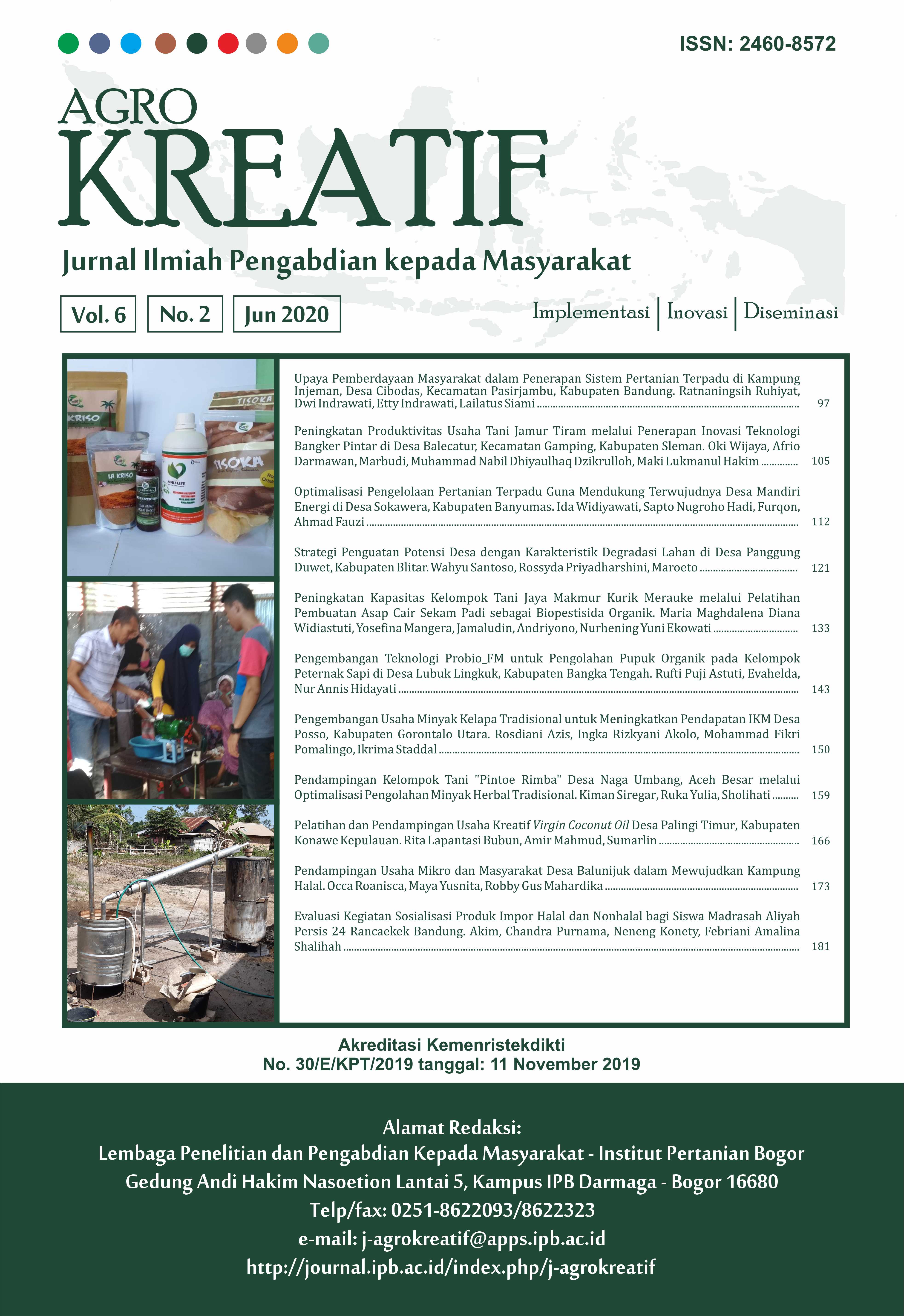Optimalisasi Pengelolaan Pertanian Terpadu Guna Mendukung Terwujudnya Desa Mandiri Energi di Desa Sokawera, Kabupaten Banyumas
Abstract
Most residents in Sokawera Village work as farmers. Population income figures are relatively low, averaging less than IDR 10,000/capita/day. Sokawera village has local potentials that have not been optimally managed, namely independent cattle farms and smallholder coconut plantations. The aim of this activity is to empower the community to optimize the management of eco-friendly integrated agriculture sourced from local potential to support the realization of an energy self-sufficient village. The strategy used in this activity is through the PRA (Participatory Rural Appraisal) approach through the methods of education, training, demonstration plots, and assistance and are equipped with learning techniques while working (learning by doing). This activity began with the implementation of extension activities and transfer of knowledge about the benefits of eco-friendly integrated agriculture, training on the making and utilization of local resources to support the optimization of the management of eco-friendly integrated farming systems such as cattle dung into biogas, biogas waste into liquid and solid organic fertilizers, and coconut shell waste into liquid smoke biopesticides, training in making demonstrations and plots (demonstration plots) of healthy vegetable cultivation, training in processing local agricultural products into value-added products, and training in product marketing strategies through the design and manufacture of attractive product packaging. This activity provides knowledge and skills to the target community regarding the management of local potential such as cow dung waste and coconut shell to optimize environmentally friendly integrated agriculture. This activity is also a starting point for the realization of an energy self-sufficient village. Biogas which is processed from livestock manure is used successfully to replace LPG.
Downloads
References
Artayana KCB, Kusuma IGBW, Adnyana IWB. 2017. Pengaruh variasi konverter biogas terhadap unjuk kerja pada mesin genset berkapasitas 1200 watt. Logic: Jurnal Rancang Bangun dan Teknologi. 14(3): 199‒206.
Darmawan D. 2017. Pengaruh kemasan dan harga terhadap keputusan pembelian produk sayuran hidroponik. Agrimas. 1(1): 1‒10. https://doi.org/10.31227/osf.io/vcsg3
Habibah, Wahdi A. 2019. Pemanfaatan limbah peternakan untuk pupuk organik sebagai sarana pemberdayaan usaha tani di kelompok wanita tani sri rejeki desa bentok darat, kecamatan bati-bati, kabupaten tanah laut. Pro Sejahtera. 1: 15‒19.
Harsono SS. 2018. Inovasi teknologi pembuatan asap cair dari tempurung kelapa di Kabupaten Situbondo. Warta Pengabdian. 2(4): 157‒169.
Juwito AF, Haryono T. 2013. Optimisasi energi terbarukan dalam pembangkitan energi listrik menuju desa mandiri energi di Desa Margajaya. Jurnal Nasional Teknik Elektro dan Teknologi Informasi (JNTETI). 2(3): 40‒48.
Kementerian ESDM. 2011. Handbook of Energy & Economic Statistics of Indonesia. [Internet]. [Diakses Pada:]. Tersedia pada: https://www.esdm.go.id/assets/media/content/content-handbook-of-energy-economic-statistics-of-indonesia-2010-c19rfkq.pdf diakses 20 Maret 2020
Kementerian ESDM. 2018. Handbook of Energy and Economics Statistics of Indonesia. [Internet]. [Diakses Pada:]. Tersedia pada: https://www.esdm.go.id/assets/media/content/content-handbook-of-energy-and-economic-statistics-of-indonesia-2018-final-edition.pdf diakses 20 Maret 2020
Nugroho A, Aisyah I. 2013. Efektivitas asap cair dari limbah tempurung kelapa sebagai biopestisida benih di gudang penyimpanan. Jurnal Penelitian Hasil Hutan. 31(1): 1‒8. https://doi.org/10.20886/jphh.2013.31.1.1-8
Oktavia I, Firmansyah A. 2016. Pemanfaatan teknologi biogas sebagai sumber bahan bakar alternatif di sekitar wilayah operasional PT. Pertamina EP Asset Prabumulih Field. Jurnal CARE; Jurnal Resolusi Konflik, CSR dan Pemberdayaan. 1(1): 32‒36.
Pangestu EI, Suswanto, Supriyanto. 2014. Uji penggunaan asap cair tempurung kelapa dalam pengendalian Phytoptora sp. penyebab penyakit busuk buah kakao secara in vitro. Jurnal Perkebunan dan Lahan Tropika. 4(2): 39‒44.
Profil Desa Sokaware. 2020. [Internet]. Diakses pada: 18 Desember 2019. Tersedia pada: http://sokawera-cilongok.desa.id/.
Semin AZM, Fathallah B, Cahyono IM, Ariana, Sutikno. 2014. Kajian pemanfaatan kotoran sapi sebagai bahan bakar biogas murah dan terbarukan untuk rumah tangga di boyolali. Sitekin. 11(2): 212‒220.
Tim pengkajian bioindustri kelapa. 2015. Inovasi Teknologi Pembuatan Asap Cair dari Tempurung Kelapa. BPTP Riau (ID).
Widyastuti A, Berlian S, Afghani J. 2013. Karbon aktif dari limbah cangkang sawit sebagai adsorben gas dalam biogas hasil fermentasi anaerobik sampah organik. Jurnal Kimia Khatulistiwa. 2(1): 30‒33.
This work is licensed under a Creative Commons Attribution-NonCommercial 4.0 International License.



















